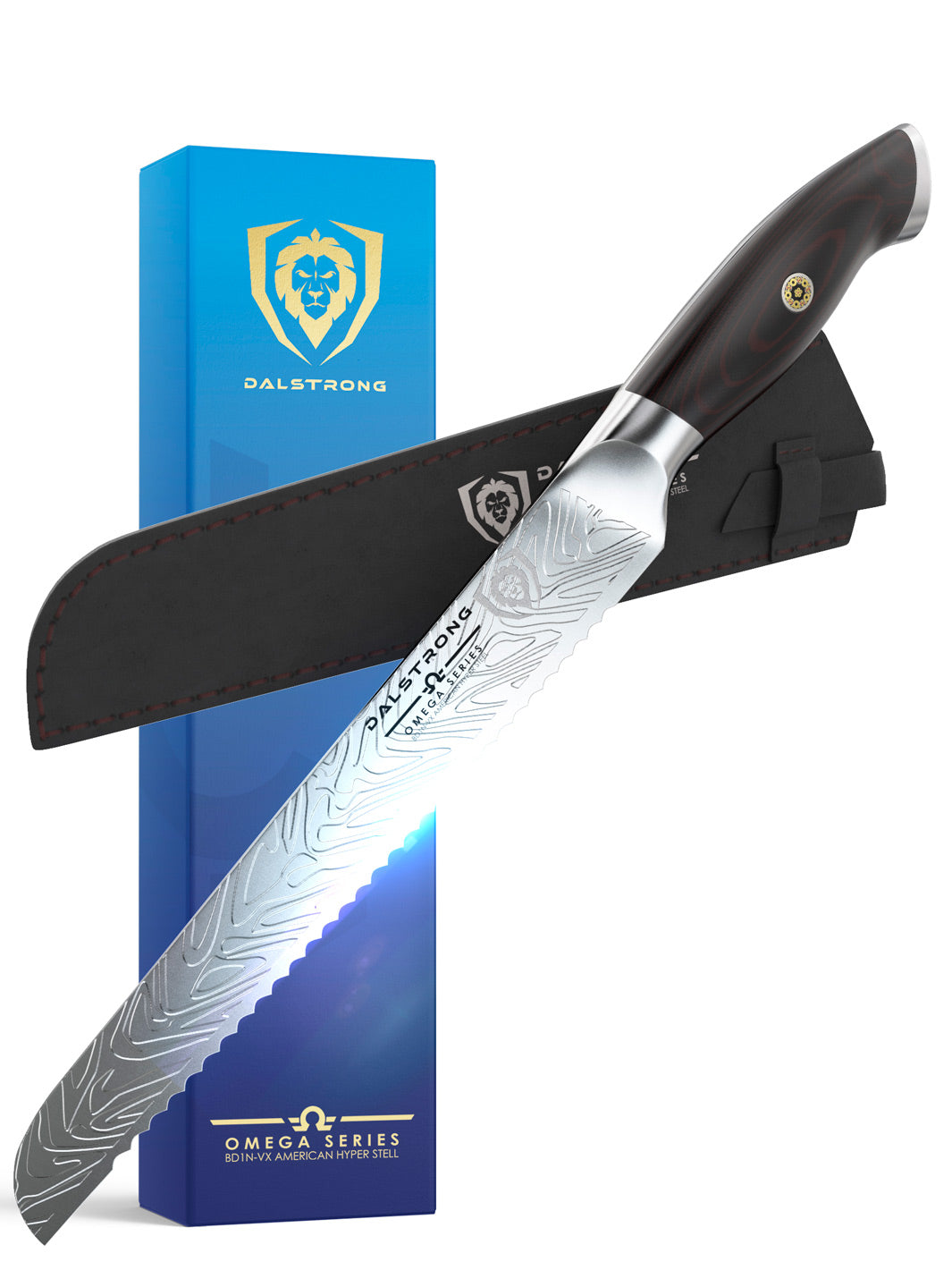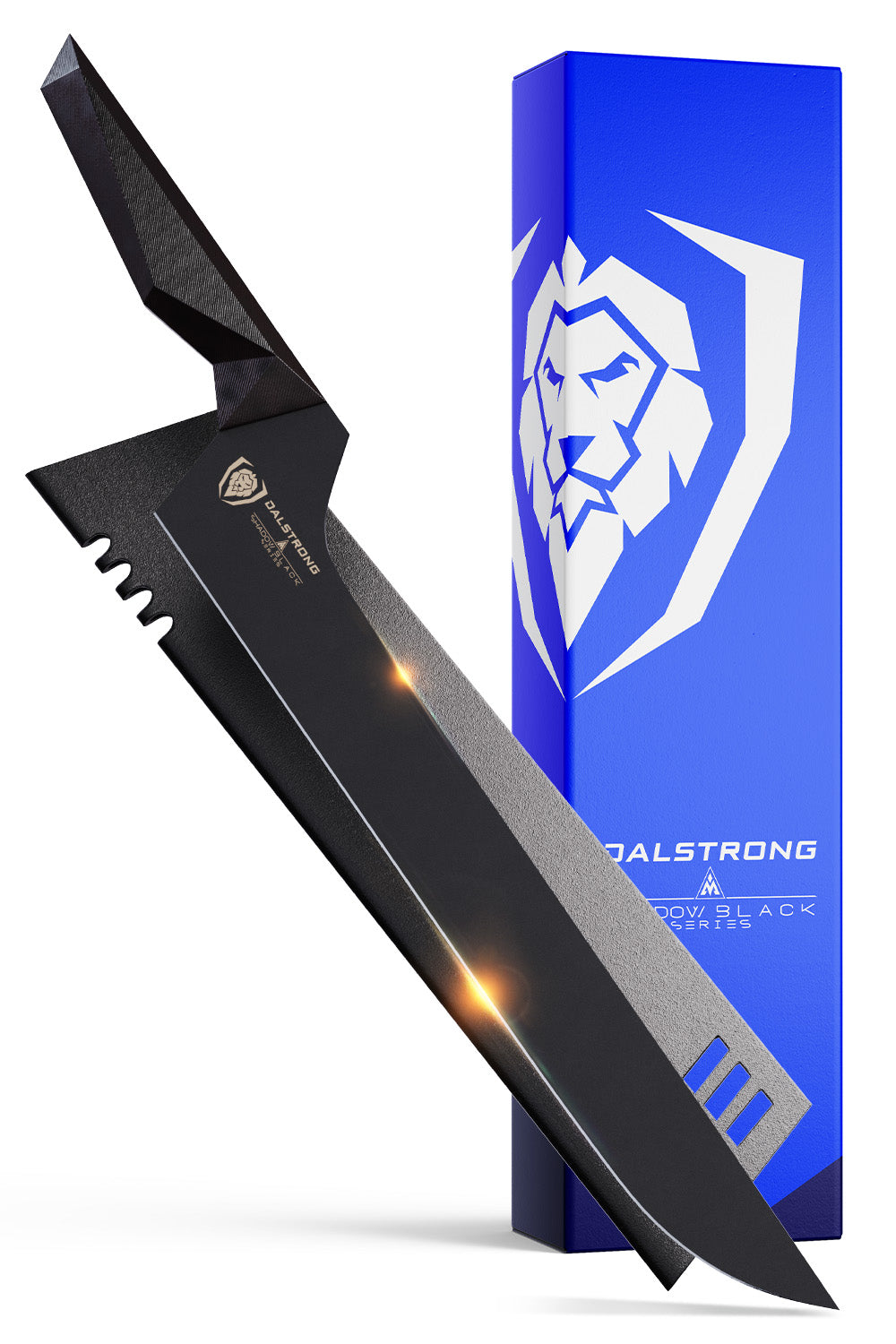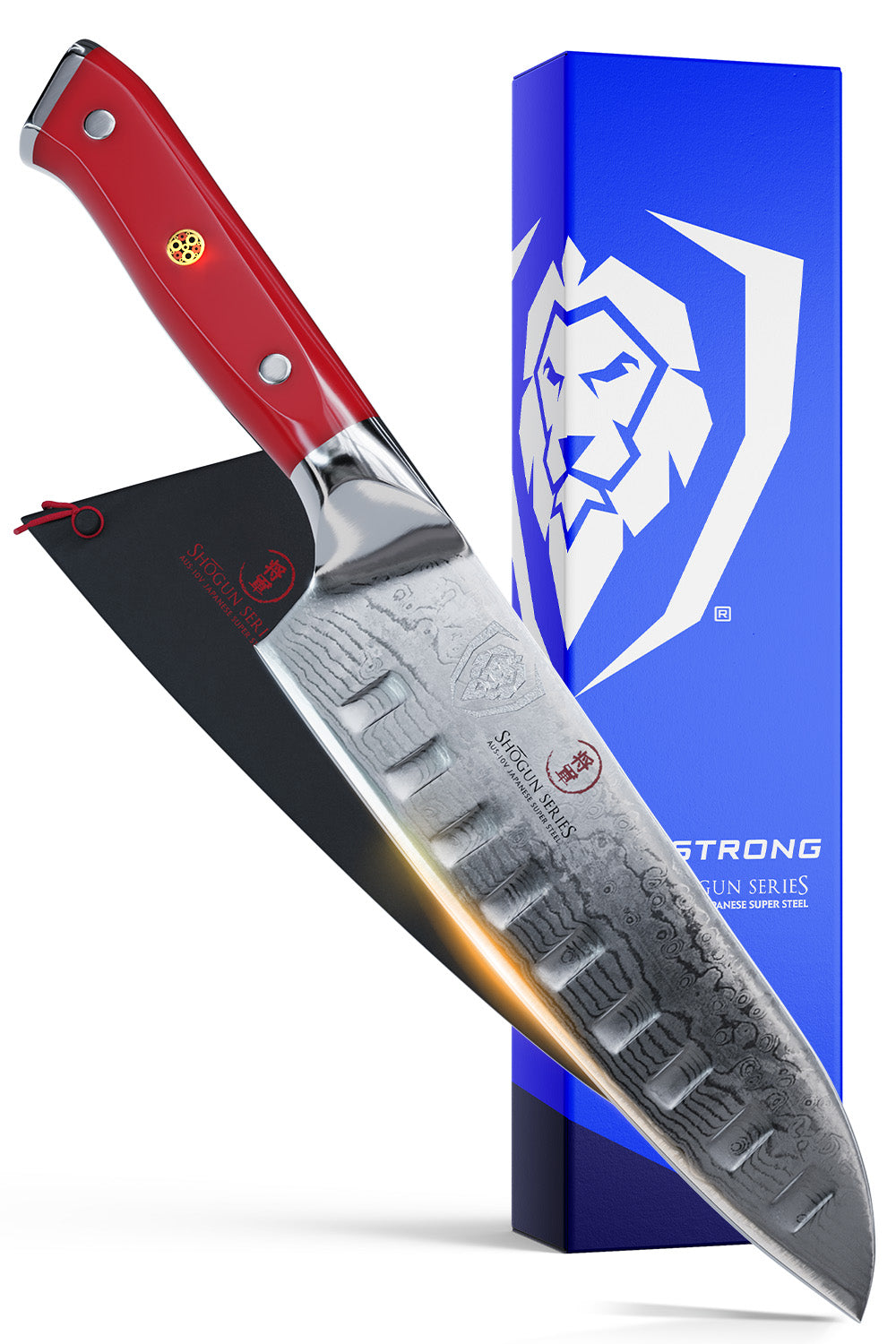 Serrated Tomato Knife 5" Gladiator Series NSF Certified Dalstrong
Serrated Tomato Knife 5" Gladiator Series NSF Certified Dalstrong
QUICK OVERVIEW: HOW TO SLICE A TOMATO (More details in section 2)
- Choose a ripe tomato.
- Wash the tomato.
- Prepare the cutting board.
- Hold the tomato.
- Position the knife.
- Make the first cut.
- Continue slicing.
- Use a rocking motion. (optional)
- Discard the ends.
- Store the tomato slices. (optional)
Welcome to the succulent world of culinary delights, where the vibrant red hue of a ripe tomato is about to take center stage! Slicing a tomato might seem like a simple kitchen task, but do not be deceived by its apparent simplicity. For within the humble curves of this luscious fruit lies a culinary adventure waiting to unfold. A journey that promises to elevate your cooking game and awaken your taste buds like never before.
As we embark on this flavorful expedition, we'll uncover the art of precision, the secrets of texture, and the dance of flavors that only a perfectly sliced tomato can orchestrate. So, buckle up your apron, sharpen those knives, and let's slice and dice our way into tomato ecstasy!
1. How To Choose Fresh Tomato
 Serrated Tomato Knife 5" Gladiator Series NSF Certified Dalstrong
Serrated Tomato Knife 5" Gladiator Series NSF Certified Dalstrong
Choosing fresh tomatoes is essential to ensure you get the best flavor and quality for your dishes. Here are some tips on how to select fresh tomatoes:
Look for vibrant color
Choose tomatoes that have a rich, vibrant color. The shade will vary depending on the tomato variety, but generally, ripe tomatoes should have a bright red, orange, or yellow hue, depending on the type.
Check for firmness
Gently squeeze the tomato wedges to assess their firmness. A ripe tomato should be firm but yield slightly to gentle pressure. Avoid tomatoes that are too hard or too soft, as they may be underripe or overripe, respectively.
Inspect the skin
The skin of a fresh tomato should be smooth and taut, without any wrinkles or blemishes. Avoid tomatoes with cracks, cuts, bruises, or moldy spots.
Smell the tomato
Ripe tomatoes often have a sweet, earthy aroma. Give the stem end a sniff; it should have a pleasant tomato scent. However, if it smells sour or musty, it might be past its prime.
Consider the weight
Ripe tomatoes should feel relatively heavy for their size. Heftier tomatoes are more likely to be juicy and flavorful.
Check the stem
If the tomato still has its stem attached, make sure it's green and looks fresh. A dried or withered stem might indicate an older or less fresh tomato.
Know the variety
Different types of tomatoes have different characteristics. For example, beefsteak tomatoes are large and meaty, while cherry tomatoes are small and sweet. Know the variety you need for your recipe and choose accordingly.
Buy in-season
Tomatoes are at their best when they are in-season locally. In-season tomatoes are more likely to be fresher, tastier, and more affordable. Check the local produce calendar or ask your grocer about the best time to buy tomatoes.
Consider the use
Think about how you plan to use the tomatoes. If you're using them for slicing, tomato salad, or sandwiches, choose larger, firmer tomatoes. For sauces or cooking, you might opt for slightly softer tomatoes.
Buy from reputable sources
Purchase tomatoes from reputable grocery stores, farmer's markets, or local vendors known for offering fresh and high-quality produce.
Remember that tomatoes continue to ripen after being picked. If you can't find perfectly ripe tomatoes, you can purchase slightly underripe ones and allow them to ripen at room temperature. Store ripe tomatoes at room temperature or in a cool, dry place, but avoid refrigerating them, as this can influence their texture and flavor.
2. How To Slice A Tomato Step-By-Step
 Serrated Tomato Knife 5" Gladiator Series NSF Certified Dalstrong
Serrated Tomato Knife 5" Gladiator Series NSF Certified Dalstrong
Dicing tomatoes is an easy task, but it's vital to use a sharp knife and practice caution to keep away from accidents. Here's a step-by-step guide to slicing a tomato:
Materials you'll need:
- Ripe tomato
- Sharp knife (chef knife or utility knife)
- Cutting board
Instructions:
- Choose a ripe tomato: Choose a tomato that is fully ripe but still hard. Avoid using overripe tomatoes as they might be too difficult and soft to slice and dice neatly.
- Wash the tomato: Wash the tomato under cool, running water to take off any dirt or debris from the surface. Pat it dry with a clean cloth or paper towel.
- Prepare the cutting board: Put a clean cutting board on a secure surface. It's vital to have an even and steady surface for efficiency and safety.
- Hold the tomato: With one hand, hold the tomato firmly but lightly, keeping your fingers away from the cutting tomato area. You can hold the tomato from the top and bottom or hold it horizontally with your fingers on opposite sides.
- Position the knife: Take the sharp knife in your other hand and hold it with a firm grip.
- Make the first cut: Position the knife's blade near the top of the tomato and slice it downward, creating a smooth, even cut through the tomato wedges. Target for the desired thickness of the slices (typically 1/4 to 1/2 inch or about 0.6 to 1.3 cm).
- Continue slicing: Keep the tomato in place and continue cutting the quarters tomato through the entire tomato, maintaining steady thickness for each slice. Remember to keep your fingers clear of the knife's path at all times.
- Use a rocking motion (sawing motion): Some people find it effortless to use a gentle rocking motion while slicing through the tomato wedges. This technique can give better control and prevent the knife from crushing the tomato to get thin strips.
- Discard the ends: Once you've sliced the tomato wedges, you'll be left with the ends. You can choose to throw away them or use them for other purposes like cooking tips or composting.
- Store the tomato slices (optional): If you're not using all the tomato slices right away, you can store them in a container in the fridge for a day or two. However, dice tomatoes are the finest when consumed fresh for meal plans.
Remember, always exercise care when handling sharp knives, and keep your fingers away from the blade to prevent accidental cuts. If you're hesitant about your knife skills, think about taking a basic knife skills class or watch instructional videos for directions.
3. Recommended Dalstrong Knives For Slicing Tomatoes
1. 3-Piece Paring Knife Set Gladiator Series Dalstrong
Introducing the Dalstrong Gladiator Series 3-Piece Paring Knife Set. A formidable trio crafted for precision and versatility in your culinary journey. Each knife is meticulously designed to excel at peeling, slicing, and intricate tasks, providing you with the ultimate control and maneuverability in the kitchen.
PROS:
- High-carbon German steel ensures long-lasting sharpness and resilience.
- Versatile set suitable for a wide range of peeling, slicing, and detail work.
- Suitable for professional chefs and home cooks seeking excellence in their kitchen tools.
CONS:
- Paring knives are small and may not be suitable for tasks that require larger blades.
- The ultra-sharp edge requires careful handling to avoid accidental cuts.
- Premium quality comes at a higher price point for those on a tight budget.
2. Serrated Knife Tomato 5" Gladiator Series Dalstrong
The serrated knife Tomato from Dalstrong's Gladiator Series is a versatile and reliable tool designed specifically for effortlessly slicing through tomatoes and other delicate fruits and vegetables. Crafted with precision and quality, this 5-inch knife features a razor-sharp serrated knife to cut edge that glides through tough tomato wedges skins and delicate flesh with ease, ensuring clean and precise cuts every time. Its carefully balanced design and ergonomic handle provide excellent control and comfort during extended use.
PROS:
- The razor-sharp serrated knife to cut edge makes slicing, dice tomatoes and other soft fruits and vegetables a breeze, preventing squishing and maintaining the integrity of the produce.
- Although designed for tomatoes, it can also handle other delicate items like citrus fruits and ripe avocados with equal precision.
- The ergonomic handle design ensures a comfortable grip and excellent control, reducing hand fatigue during extended use.
CONS:
- The length of this knife could be a little short if you’re working with heirloom tomatoes as they’re a little larger in size than Roma tomatoes.
3. Serrated Sandwich, Deli & Utility Knife 6" Gladiator Series Dalstrong
Dalstrong Gladiator Series 6" Serrated Knife Sandwich, Deli & Utility. The ultimate companion for perfect cuts and culinary excellence. This multipurpose knife is a game-changer for sandwich aficionados and kitchen enthusiasts alike. With its razor-sharp, scalloped edge, effortlessly glide through crusty bread, succulent meats, and delicate tomatoes, preserving textures and flavors with every slice and dice.
PROS:
- Scalloped edge excels at slicing through sandwiches, deli meats, and other delicate foods.
- High-carbon German steel delivers exceptional sharpness and longevity.
- A must-have for sandwich lovers and cooks seeking a reliable utility knife.
CONS:
- If you’re looking for a knife to do more than just cut the tomato wedges, and even peel the tomatoes, a paring knife might be a better fit.
4. 3 Piece Paring Knife Set Shogun Series Elite Dalstrong
Dalstrong Shogun Series Elite 3-Piece Paring Knife Set. A trifecta of precision and power, designed to elevate your culinary expertise. Crafted with exquisite craftsmanship, each knife in this set is a testament to the fusion of artistry and performance. The ultra-sharp blades, meticulously hand-finished to a 8-12° angle per side, effortlessly glide through fruits, vegetables, and intricate tasks, allowing for flawless cuts and impeccable presentation.
PROS:
- Razor-sharp blades hand-finished to a precise angle, ensuring effortless and precise cuts.
- G10 Garolite handles offer a comfortable and secure grip for enhanced control.
- Exquisite craftsmanship and aesthetics add elegance to your kitchen tools.
CONS:
- As a 3-piece set of paring knives, the size range is limited to smaller blades, which may not meet all cutting needs in the kitchen.
5. Fruit & Vegetable Paring Knife Set - 3 Piece Gladiator Series ELITE Dalstrong
Dalstrong Gladiator Series ELITE 3-Piece Fruit & Vegetable Paring Knife Set - a triumphant trio crafted to conquer all your culinary challenges. From delicate fruits to hearty vegetables, these knives effortlessly glide through with expert finesse, making every cut a masterpiece. Handcrafted from high-carbon German steel and honed to perfection, their scalpel-like edges ensure razor-sharp performance.
PROS:
- Versatile set designed to handle a wide range of culinary tasks.
- A perfect addition to both professional kitchens and home cook's culinary arsenal.
- High-carbon German steel offers outstanding durability and edge retention.
CONS:
- Paring knives are generally smaller in size, and while they excel at precision tasks, they may not be the best option for cutting the quarters larger items or handling heavy-duty kitchen duties.
- It's specifically tailored for intricate work on fruits and vegetables.
4. Frequently Added Questions
What is the easiest way to slice a tomato?
With practice, cutting tomato becomes a easy and quick task. Always use a sharp chef knife and exercise caution to prevent accidents and achieve precise , clean slices.
How do you cut tomato pieces?
First rinse the tomato, cut off the top of the tomato, cut the tomato in half, cut out the core and cut into cubes. Remember to use a sharp chef knife for clean cuts.
How do chefs slice tomatoes?
Wash the tomato, cut off the top, cut the tomato in half, cut out the core and cut into cubes. It's vital to note that each chef may have their individual approach to slicing, dice tomatoes, and their techniques may change based on the specific dish they're preparing.
How many slices in a tomato?
The number of slices you can get from a tomato depends on the size of the tomato and the thickness of the slices you cut. Normally, a medium-sized tomato, about 6 to 7.5cm (2.5 to 3 inches) in diameter, can yield around 4 to 6 slices.
SHOP DALSTRONG PARING KNIVES














